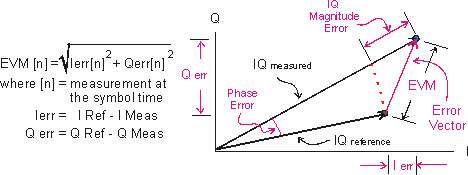EVM (802.11b/g DSSS/CCK/PBCC)
EVM Error vector magnitude (EVM): A quality metric in digital communication systems. See the EVM metric in the Error Summary Table topic in each demodulator for more information on how EVM is calculated for that modulation format. (error vector magnitude) is the magnitude of the error vector at the measured chip location. The error vector is the vector difference between the I/Q measured signal phasor and the I/Q reference signal phasor:
-
EVM (%rms) is the Root Mean Square of the error vectors, within the measurement interval, computed and expressed as a percentage of the square root of the mean power of an ideal signal.
-
EVM Pk at chip is the EVM and number of the chip with the worst-case peak EVM expressed as a percentage of the square root of the mean power of the ideal signal.

The 89600 also provides the normalized Error Vector Magnitude as defined in section 18.4.7.8 "Transmit modulation accuracy", of the IEEE Institute of Electrical and Electronics Engineers. A US-based membership organisation that includes engineers, scientists, and students in electronics and related fields. The IEEE developed the 802 series wired and wireless LAN standards. Visit the IEEE at http://www.ieee.org Std 802.11-2007 Wireless LAN Local Area Network: A communications network that serves users within a local geographical area, typically over distances of around 100m. Wireless LANs use wireless communicaitons to network devices so there is no need for data cabling. specification (see 802.11b Peak EVM).
See Also
